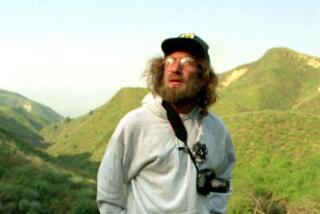C. Patterson; Fought Lead Contamination
- Share via
Clair C. (Pat) Patterson, a Caltech geochemist who scientifically dated the age of the Earth and discovered lead contamination in modern humans, leading to the Clean Air Act of 1970, has died. He was 73.
Patterson, who had taught and done research at Caltech for four decades, died Tuesday at his home in Sea Ranch in Northern California.
Often referred to on campus as “the lead man” for his research determining that modern humans contain 1,000 times the lead of their prehistoric ancestors, Patterson argued that lead in combination with calcium cakes bones, clogs kidneys and diminishes children’s intelligence.
Based on his research begun in 1960, environmentalists have obtained curbs on lead-based paints, ended the sealing of canned goods with lead solder and passed the Clean Air Act to reduce lead emissions from cars burning leaded gasoline. The U.S. Environmental Protection Agency later showed that the act in its first 20 years cut lead emissions 96%.
Earlier this year, in recognition of his lead research, Patterson was awarded the top international environmental award, the Tyler Prize for Environmental Achievement.
Patterson considered his efforts to save humanity from lead a way of practicing socially responsible science, and penance for his early research in Chicago and Oak Ridge, Tenn., in developing the atomic bomb during World War II.
“It was the greatest crime that science has committed yet,” he told The Times in 1990. “We burned 100,000 Japanese alive. . . . [I] helped to burn them alive.”
A plain-spoken scientist, Patterson often irked colleagues as well as manufacturers who were reluctant to give up their lead-containing products. Despite his considerable accomplishments, he was not well known.
His first landmark research occurred in 1953 when he decisively pinpointed the age of the Earth at 4.6 billion years. Scientists had argued over the issue for centuries, generally agreeing on about 3 billion years.
But Patterson applied a then-new technology of radiometric dating, in which the rates of decay of elements such as uranium were used to establish the precise ages of rocks. His figure of 4.6 billion years has not been seriously disputed since he established it.
Born in Mitchellville on Iowa’s Skunk River, Patterson grew up teaching himself chemistry in the basement of his family home. He went to Grinnell College in Iowa, earned a master’s at the University of Iowa and a doctorate from the University of Chicago. He joined Caltech in 1952.
Patterson was elected to the National Academy of Sciences in 1987, after winning its J. Lawrence Smith Medal in 1975. He also earned the Professional Achievement Award of the University of Chicago in 1981 and has had an asteroid and a peak in Antarctica named for him.
He is survived by his wife, Lorna, four children, a brother and sister, and three grandchildren.






